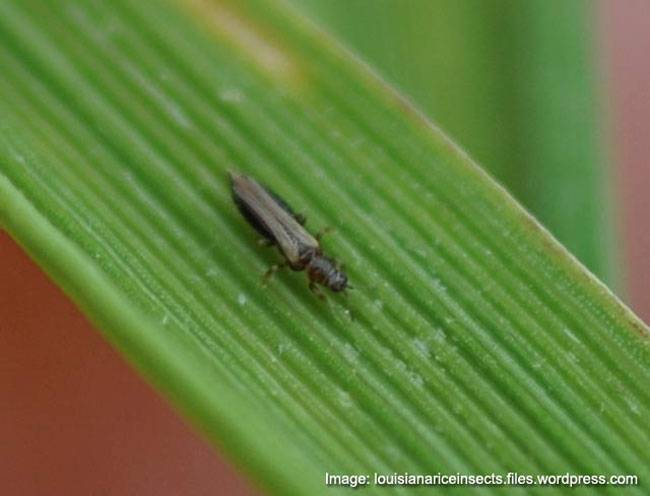Rice thrips are tiny but impactful pests that attack rice crops, particularly during the seedling stage. These insects cause significant damage through their feeding activity, leading to leaf curling, discoloration, and drying, which can drastically reduce crop yields.
Symptoms of Damage
- Discoloration and rolling of leaves.
- Yellow or silvery streaks on young seedling leaves.
- Terminal rolling and drying of leaves from tip to base.
- Severe infestations cause leaf tips to wither off.
- Thrips damage both nursery and main field crops.
Life Cycle Stages
Egg
- Tiny, hyaline eggs turn pale yellow as they mature.
- Eggs are laid in slits of leaf blade tissue, with the upper half exposed.
Nymph
- Neonates are transparent and later turn pale yellow by the second molt.
- Legs, head, and antennae darken slightly in the second instar stage.
Pupa
- Long wing pads reaching two-thirds the length of the abdomen.
- Four pointed processes on the ninth abdominal tergite.
Adult
- Slender dark brown body, 1-2 mm long.
- Exists in winged and wingless forms; winged adults have elongated narrow wings fringed with long hairs.
What It Does
Thrips feed on soft tissues of unopened young leaves, causing:
- Silvery streaks or yellowish patches on leaves.
- Translucent epidermis visible on damaged areas.
- Leaf curling from the margin to the middle.
- Unfilled grains at the panicle stage in severe infestations.
Why and Where It Occurs
- Favorable Conditions: Dry weather and fields with no standing water encourage thrip development.
- Timing: Common during dry periods (July-September and January-March in the tropics).
- Habitat: Found in all rice environments; migrates and hibernates on graminaceous weeds during winter.
How to Identify
Visual Signs:
- Silvery streaks or yellow patches on leaves.
- Rolled leaves with thrips inside.
- Leaf tips dry and wither in severe cases.
Insect Identification:
- Eggs visible on leaf tissue, with upper halves exposed.
- Yellow larvae and dark brown adults feeding on plant tissues.
Why It’s Important
- Thrips cause significant damage during the seedling stage or within two weeks of early sowing.
- In direct-seeded rice fields, losses can reach up to 100% within 20 days after sowing during severe infestations.
Management Strategies
Cultural Practices
- Flood and submerge infested fields for two days.
- Use resistant rice varieties (consult local agriculture offices for updated lists).
Biological Control
- Encourage natural predators like predatory thrips, coccinellid beetles, anthocorid bugs, and staphylinid beetles.
Rice thrips are a persistent threat to rice crops, particularly in dry climates. Effective management through cultural practices and natural predators can significantly reduce their impact, safeguarding yields and ensuring healthy crop development.
